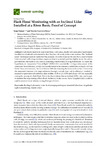Flash flood monitoring with a inclined Lidar installed at a river bank: proof of concept
Resumen
Flash floods need to be monitored from a safe place, ideally with noncontact instruments installed at a riverbank and oriented so that they look obliquely at the water surface. The “inclined Lidar” technique could be useful for this purpose. It works based on the fact that a near-infrared Lidar mounted with a large incidence angle can detect suspended particles slightly below the surface, provided that the water is very turbid, something which is likely during flash floods. To check this hypothesis, an inexpensive “time of flight” (TOF) Lidar was installed during a rainy season at the Amacuzac River (Mexico), which was usually found to be extremely turbid (Secchi depth < 0.5 m). Under these circumstances, the Lidar had no difficulty detecting the water (sub) surface. Converting the measured distances into stage estimates through a simple (one point) calibration resulted in reasonable agreement with reference data (within _0.08 m (p = 0.95) and always <0.5 m), especially during the passing of a flash flood. This is the first evidence that an inclined (TOF) Lidar can be used to monitor the stage during a flash flood. Indirectly, it also shows that a (Doppler) Lidar could be used to monitor water velocity during this type of event.
Fuente
Remote Sensing, (8)10
Materia
INGENIERÍA Y TECNOLOGÍA
Colecciones
- Artículos de revistas [101]
El ítem tiene asociados los siguientes ficheros de licencia:


